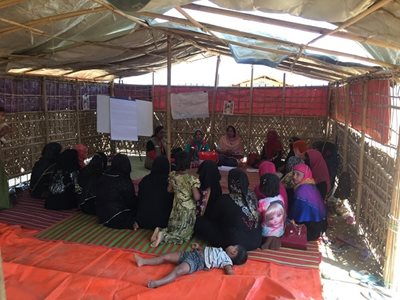August 25, 2019 marks two years since the Bangladesh Population Movement began. Since 2017, more than 700,000 people have fled violence in Myanmar’s northern Rakhine state for Bangladesh. While there are many local volunteers and workers on the ground, many international aid workers, like Canadian Red Crosser Norine Naguib, continue to support the efforts there.
Norine, the Canadian Red Cross field coordinator in Bangladesh, first got involved with the Red Cross as an intern scouring international archives to uncover the rich history of the Canadian Red Cross. Having now spent nearly seven years working with the Red Cross, Norine is the Canadian Red Cross in-country representative for the population movement response.
 In her role in Bangladesh, Norine explains that she and her team “work at providing primary health services for the displaced population. We continue to strive to improve the quality of our health services in the camps and to reach as many people as possible.”
In her role in Bangladesh, Norine explains that she and her team “work at providing primary health services for the displaced population. We continue to strive to improve the quality of our health services in the camps and to reach as many people as possible.”She’s also worked to increase the diversity, quality and quantity of resources to ensure they’re what those in the camps need most. “When we added a female doctor to our team, female patients quickly lined up to see her,” Norine explains.
A key part of Norine’s job involves working with the Bangladesh Red Crescent Society and helping liaise between the Canadian Red Cross and other Red Cross groups in-country as well as coordinating with the other humanitarian actors on the ground.
The Canadian Red Cross first became active in the population movement response in October 2017 in Cox’s Bazar, where the camps are located. The camps are incredibly densely populated, the average space per person is 24 square metres, falling to just 10 square metres in the most densely crowded areas, much below international standards.
Over the last two years, the scene at the camps has grown into some level of stability despite the volume of people; however, recurring monsoons and fires reveal the extreme vulnerability of the bamboo camps, greatly affecting safety and security.
While coordination among humanitarian organizations – including data collection and sharing – has improved over time, there remain difficulties. With no end in sight, there are differing opinions among humanitarian groups regarding the future of the response.
Going forward, Norine emphasizes the need to keep the Bangladesh Red Crescent Society in the forefront of decision-making, since they will be last ones on the ground as the international presence decreases.
Despite working as part of a difficult response, Norine says she enjoys supporting and motivating the dedicated workers that make up her team. By the time her mission ends, Norine says: “I hope to leave the health team in a positive, well-functioning and confident state in which it can be proud of the services it continues to provide to the most vulnerable, long after we leave.”
Yassen Atallah is a MA candidate at the Norman Paterson School of International Affairs, studying International Affairs with a focus on International Organizations and Global Public Policy. He recently completed a BA in International Relations at the University of British Columbia.

